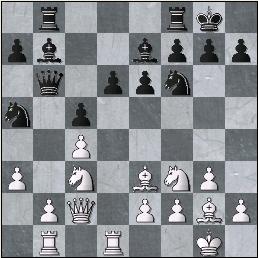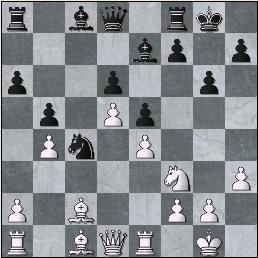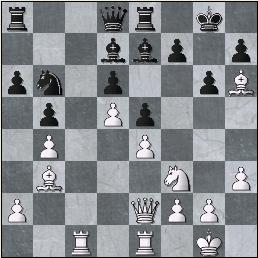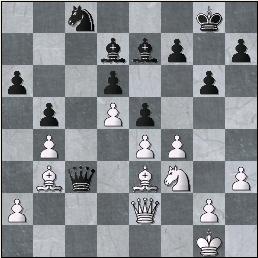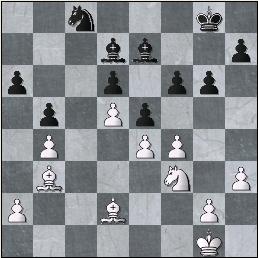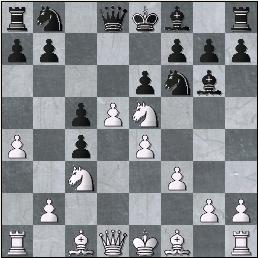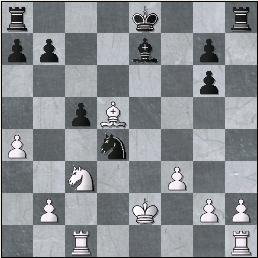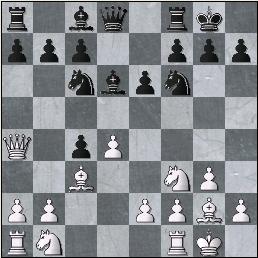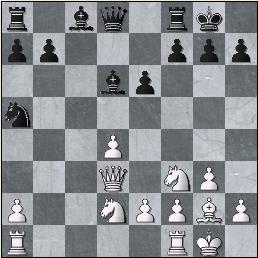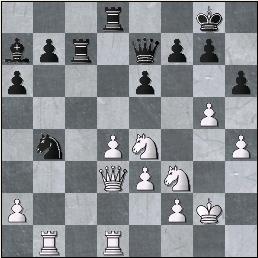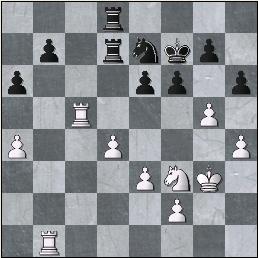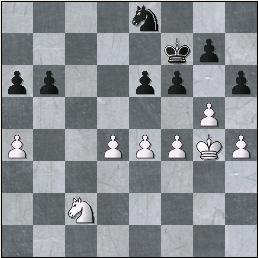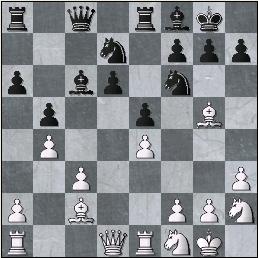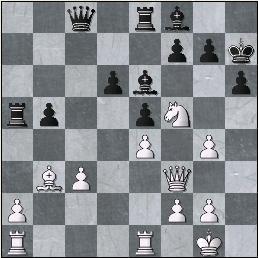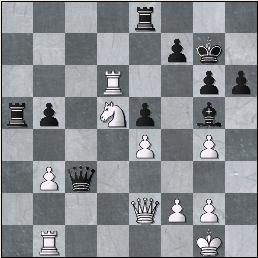16.11.2006
TAL MEMORIAL. GAMES OF ROUND 8 COMMENTED
Round 8 is one of the most peaceful rounds of this tournament. Only one victory was achieved, and none of 4 remaining games was seriously unbalanced at any moment. We are too much accustomed to complex fight in this tournament to be any impressed with comparatively colourless draws. But we understand the exhausted contestants who save the remainders of power to be able to cross the finish line.
Aronian,L (2741) - Grischuk,A (2710) [E17]
Tal Memorial Moscow RUS (8), 15.11.2006
1.d4 ¤f6 2.c4 e6 3.¤f3 b6 4.g3 Ґb7 5.Ґg2 Ґe7 6.¤c3 White refrains from immediate castling. This gives him some additional opportunities after the standard 6...¤e4.
6...0-0 7.Јc2 Another way for white to fight for the advantage is 7.d5
7...c5 8.dxc5 White refrains from principal 8.d5 exd5 9.¤g5 or 9.¤h4. The rest is predictable.
8...bxc5 9.0-0 d6 10.¦d1 Јb6 11.Ґe3 ¤c6 12.¦ab1 ¦ab8 13.a3 ¤a5
This way black avoids a7-a5 that would give white knight a good square on b5. Now as Grischuk mentioned is refuted by 14.b4? ¤xc4 15.bxc5 Јa6!-/+ (but not 5...¤xe3? 16.cxb6 ¤xc2 17.bxa7+-)
14.b3 h6 15.h3 ¦fd8 16.g4 1/2-1/2
And one more quotation from Grischuk: "By now, the players are still endowed with the right to agree to draw."
Although for the spectators such games may evoke indignation, none of the profies would blame the players for such a decision. And I doubt any spectator would blame a tennis player who will reduce his velocity in the 5th set. If an athlete cannot run as fast as in the beginning anymore he slows down, otherwise he simply falls unconscious. A game is just a part of the tournament like a set is a part of a match and a lap is a part of a distance.
Leko,P (2741) - Mamedyarov,S (2728) [C96]
Tal Memorial Moscow RUS (8), 15.11.2006
1.e4 e5 2.¤f3 ¤c6 3.Ґb5 a6 4.Ґa4 ¤f6 5.0-0 Ґe7 6.¦e1 b5 7.Ґb3 d6 8.c3 0-0 9.h3 ¤a5 10.Ґc2 c5 11.d4 ¤d7 12.d5 ¤b6 13.¤bd2 g6!? As long as the Breyer line Mamedyarov prepared for this tournament gave a big crack, he applies an approach reasonable from a practical point of view. He still adhere to the solid old Ruy Lopez but eliminates opponents` preparation by choosing rare subvariations of each time different lines. 13...f5 is a mainstream of the system.
14.b4 The position can be traced back for whole four decades! White applied another plan: 14.g4 ¦a7 15.¤f1 Ґf6 16.¤g3 Ґg7 17.ўh2 in Zakharov-Vatnikov, URS-chT 1966
14...cxb4 15.cxb4 ¤ac4 16.¤xc4 ¤xc4
17.Ґh6 It seems to me that Leko`s response to black`s choice was correct, but now he chooses an imprecise way. After 17.a4 Ґd7 18.Ґh6 ¦e8 19.Јe2 white could create some problems for the opponent, for example: 19...Ґf8 20.Ґxf8 ¦xf8 21.Ґd3
17...¦e8 18.Ґb3 18.Јe2 would still lead to the previous note; to give up a bishop is feeble:18.a4 ¤b2 19.Јe2 ¤xa4 20.Ґxa4 bxa4 21.¦xa4 Јb6 22.¦ea1 Ґd7=
18...Ґd7 19.Јe2 ¤b6 20.¦ac1
20...¦c8 21.Ґe3 ¦xc1 22.¦xc1 Јb8 23.¤d2 Leko fairly mentions 23.¦c6? is refuted by 23...Ґxc6 24.dxc6 ¤c4 (I doubt even the general idea of an exchange sacrifice here,24...¦c8!? 25.Ґd5 ¤xd5 26.exd5 is hardly any good for white) 25.Ґxc4 bxc4 26.Јxc4 Јb5 If we continue the variation: 27.Јxb5 axb5 28.c7 ¦c8 29.Ґb6 f5 it becomes clear that black is winning 23...¦c8 24.¦xc8+ ¤xc8 25.f4 Јc7 26.¤f3 Јc3
27.Јd2 White could also refrain from the exchange of queens: 27.Ґd2 Јa1+ 28.ўh2 (28.Јf1 Јxf1+ 29.ўxf1 f6 is essentially the same as the game) 28...exf4 29.Ґxf4 Here as Shakhriyar said, he had prepared 29...g5! Yet I cannot believe that after 30.Ґg3 (30.Ґe3 Ґf6 (30...g4 looks dubious: 31.hxg4 Ґxg4 32.Јf2) 31.Јf2 h6 and the position is, perhaps, unclear) 30...Јc3 31.Ґe1 Јg7 32.Јe3 white`s position`s clear esthetic superiority over black`s one doesn`t imply an advantage.
27...Јxd2 28.Ґxd2 f6
29.fxe5 After that white obtains two bishops advantage but in a position he cannot penetrate. I think 29.g4 with the idea of ўf2-g3, (h3-h4), g4-g5 would give white more chances, black would sooner or later have to submit to the necessity of e5xf4.
29...fxe5 30.¤xe5 dxe5 31.d6+ ўg7 32.dxe7 ¤xe7 33.h4 Leko dreamt her of having apawn on a3 to be able to get advantage by 33.Ґg5 ¤c6 34.Ґd5...
33...Ґc6 34.Ґc2 ¤c8 35.Ґc3 ўf6 36.ўf2 ¤d6 37.ўe3 h6 38.Ґe1 ¤c4+ 39.ўf3 1/2-1/2
Gelfand`s opening alertness is really terrifying.
Shirov,A (2720) - Gelfand,B (2733) [D17]
Tal Memorial Moscow RUS (8), 15.11.2006
1.d4 d5 2.c4 c6 3.¤f3 ¤f6 4.¤c3 dxc4 5.a4 Ґf5 6.¤e5 e6 7.f3 c5 8.e4 Ґg6 9.d5!?
9.Ґe3 has been tried recently in Topalov-Kramnik, Elista m/6 2006 An interesting move in the text has just a small reference of one game in a database. And it has been thoroughly analyzed by Gelfand.
9...exd5 10.¤xg6 hxg6 11.e5 ¤fd7! After 11...¤h5 12.¤xd5 ¤a6 13.Ґe3 ¤g3 14.Ґxc4 Ґe7 15.Јb3 ¤xh1 16.0-0-0 the game Kacheishvili - ¦ogic, 7th ch-Euro Kusadasi 2006 scarcely lasted 20 moves in 12.Јxd5 ¤c6 13.e6 Gelfand claims he has deeply analyzed 13.f4 Јe7
13...fxe6 14.Јxe6+ Јe7
15.Јxe7+ After15.Ґxc4 Јxe6+ 16.Ґxe6 black has 16...¤d4 The continuation 17.Ґxd7+ ўxd7 18.ўf2 ¤b3 19.¦b1 c4 leads to a position presumably evaluated as: "black will be able to compensate his kingside weaknesses with queenside activity".
15...Ґxe7 16.Ґxc4 ¤de5 17.Ґd5 ¤d3+ 18.ўe2 ¤xc1+ 19.¦axc1 ¤d4+
20.ўf2 20.ўd3 was more challenging, the move in the text is harmless because of an important subtlety on move 21.
20...0-0-0 21.Ґf7 Ґh4+! 22.g3 ¦hf8 23.Ґd5 23.Ґxg6?! ¤xf3! 23...Ґf6 24.¦hd1 The game is equal. 1/2-1/2
Carlsen,M (2698) - Ponomariov,R (2703) [E04]
Tal Memorial Moscow RUS (8), 15.11.2006
1.d4 ¤f6 2.c4 e6 3.g3 d5 4.Ґg2 dxc4 5.¤f3 ¤c6 6.Јa4 Ґb4+ 7.Ґd2 Ґd6 This move was introduced to practice by Kramnik in his game against Karpov, 7...¤d5 is the main line. 8.0-0 Sometimes white puts off castling and play 8.Јxc4 0-0 9.Ґc3 immediately to meet 9...Јe7 with 10.¤e5
8...0-0 9.Ґc3
Carlsen prevents e6-e5 possible aftertaking on c4. Actually that`s the continuation of the first game with 7...Ґd6: 9.Јxc4 e5 took place in Karpov-Kramnik, Wijk aan Zee 1998
9...¤d5?! insisting on e6-e5 by 9...Јe7 is quite possible. After 10.Јxc4 black started complicating the matter by 10...¦d8 in Beliavsky-Krasenkov, Bundesliga 2004 I could help mentioning that traightforward 10...e5 recommended afterwards was fearlessly tried by Olsen against Olsson in Copenhagen 2005
10.Јxc4 ¤xc3 11.bxc3 ¤a5 12.Јd3 c5 13.¤bd2 cxd4 14.cxd4+/= Due to black`s 9th move white reached some pressure.
14...Ґd7 15.¤e4 Ґe7 16.h4 h6 17.¦ac1 Ґc6 18.¤e5 Ґd5 19.¤c3 Ґxg2 20.ўxg2 ¦c8 21.¦fd1 Ґa3 22.¦b1 Ґd6 23.¤f3 Јe7 24.¤e4 ¦fd8 25.¦b5 ¤c6 26.g4! a6 27.¦b6 Ґb8 28.e3 Ґa7 29.¦bb1 ¦c7 it would be ridiculous to dream of something like 29...e5? It takes no creativity from white to respond with 30.d5 Јd7 31.g5
30.g5 ¤b4
31.Јa3 Due to white`s having more space and a strong center his advantage is obvious but from now Magnus starts gradually dropping it in small portions.White is better in the endgame, but to keep the queens on the board seems to be more promising: 31.Јb3 ¤d5 and now 32.a4 or immediate 32.¦g1
31...¤d5 32.Јxe7 ¦xe7 33.¦dc1 White had here to make a choice between taking the line or quite desirable transferring the knight to d3 by 33.¤e5
33...f6 34.¤c5 With all the respect to the might of the bishop, I do not think white had to exchange it immediately. Black bishop is passive on a7 and performs a purely defensive task. 34.¦c2 is reasonable, 34.g6!? deserved attention.
34...Ґxc5 35.¦xc5 ўf7 36.ўg3 ¦ed7 37.a4 ¤e7
38.ўg4 After 38.¤e1 (with the idea ¤d3-c5) 38...¤f5+ 39.ўg4 ¤d6 white is somewhat discoordinated, 38.a5 ¤f5+ 39.ўg4 ¤d6 allowed black to cover b7 with the knight on b5. But now the exchanges continue and white`s advantage goes on decreasing.
38...¦c8 39.¦xc8 ¤xc8 40.¤e1 b6 41.¦c1 ¤e7 42.f4 ¤d5 43.e4 ¦c7 44.¦xc7+ ¤xc7 45.¤c2 ¤e8
White kept his significant space advantage till the knight endgame, but it doesn`t promise him anything feasible anymore. 46.gxh6 gxh6 47.f5 exf5+ 48.ўxf5 ¤d6+ 49.ўf4 b5 50.a5 ¤c4 51.¤b4 ¤xa5 52.¤xa6 h5 53.e5 fxe5+ 54.dxe5 ¤c6 55.ўg5 ¤xe5 56.ўxh5 ўf6 57.¤c7 b4 58.¤d5+ ўf5 59.¤xb4 ¤g6 60.¤d5 ¤xh4 1/2-1/2
Svidler,P (2750) - Morozevich,A (2747) [C92]
Tal Memorial Moscow RUS (8), 15.11.2006
1.e4 e5 2.¤f3 ¤c6 3.Ґb5 a6 4.Ґa4 ¤f6 5.0-0 Ґe7 6.¦e1 b5 7.Ґb3 d6 8.c3 0-0 9.h3 ¦e8 10.¤g5 ¦f8 11.¤f3 Svidler adds some psychology. No use trying to guess what would happen after 11...¦e8. Had he wanted draw or not, Svidler could not have afforded himself to make it this way, "when everyone watches". But to provoke Morozevich`s fighting spirit is a reasonable idea. Ґb7 12.d4 ¦e8 13.¤bd2 Ґf8 14.d5 ¤b8 15.¤f1 ¤bd7 16.¤3h2 ¤c5 17.Ґc2 c6 18.b4 ¤cd7 19.dxc6 Ґxc6 20.Ґg5 Јc8
And perhaps we see the confirmation of written above. Variation 20...h6 21.Ґxf6 ¤xf6 (d6-d5 is the threat) 22.¤g4 ¤xg4 23.Јxg4 is rather drawish if black refrains from premature 23...d5?! (Adams-Ponomariov, Linares 2002) in favour of 23...Ґd7 24.Јf3 ¦c8=
21.¤g3 A pawn sacrifice21.Ґxf6 ¤xf6 22.¤g4 ¤xg4 23.hxg4 Ґd7 24.¤e3 Јxc3 25.¤d5 Јc6 26.Ґb3 that took place first in Almasi-Bacrot, Szeged 2000 is considered to be advantageous for white, but Peter prefers another plan.
21...h6 22.Ґxf6 ¤xf6 23.Ґb3
23...a5 Black hopes to provoke a2-a3 that would rid b3-bishop of his defence, its being unprotected plays into black`s hands after planned Ґd7-e6. But white reacts correct and soon reach a small but stable edge. Carrying out releasing d6-d5 doesn`t solve all black`s problems, after 23...Јb7 24.¤g4 (24.Јf3 d5 25.¤g4 ¤xe4 26.¤xe4 dxe4 27.Јf5 also seems to give white some edge) 24...¤xg4 (24...¤xe4 25.¤xh6+) 25.Јxg4 d5 26.¦ad1+/= white`s pressure in the center is somewhat unpleasant; I think the right continuation was 23...Ґd7 24.Јf3 Ґe6 immediately. The idea behind it is to meet 25.¤f5 Ґxf5 26.Јxf5 (26.exf5 e4) with 26...d5! In the game in analogous case white woull have already an extra pawn on a5.
24.bxa5 Ґd7 25.Јf3 Ґe6 26.¤f5 ўh7 In the endgame after26...Ґxf5 27.Јxf5 (27.exf5?! is not good for white because after 27...e4 28.Јf4 ¦xa5 (or 28...Јxc3) black can meet 29.¤g4 with 29...¤h5!) 27...Јxf5 28.exf5 ¦ec8 29.¦e3 ¦xa5 30.¤g4 ¤xg4 31.hxg4+/= white keeps a durable edge though probably he cannot break through efficiently enough. 26...¤xe4? 27.Ґxe6 (or 27.¤xh6+) 27...fxe6 28.¤xh6+ is obviously bad.
27.¤g4 ¤xg4 28.hxg4 ¦xa5
White consolidates his position with some advantage: 29.¦ad1 ¦a6 30.¦d3+/= g6 31.¤e3 ўg7 32.¦b1 Ґe7 33.Јe2 ¦a5 34.¦d2 White concentrates on black`s main weakness (i.e. b5-pawn) and offers a pawn sacrifice.
34...Ґg5 Black is too impatient. Accepting the sacrifice 34...Јxc3 would give white strong pressure after 35.¤d5 (concrete approach 35.Ґxe6 fxe6 36.¦c2 Јd4 37.¦xb5 turnes white knight to a misplaced piece and eventually doesn`t promise more than draw: 37...¦xb5 38.Јxb5 ¦f8 39.¦c7 (39.a4 ¦f7!) 39...¦f7 40.Јb7 Јd2 41.¤f5+=) and now neither 35...Јc8 36.¦c2 Јd7 (36...Јb8 37.¤c7) 37.¦c7 Јd8 38.¦b7 nor 35...Ґxd5 36.Ґxd5 Ґg5 37.¦db2 bring happy relief. Black should have preferred more humble and awaiting 34...Јc5 35.¦db2 ¦b8 or 34...¦d8
35.¦xd6 Ґxb3 35...Јxc3 36.Ґxe6 ¦xe6 37.¦xe6 fxe6 38.¦b3 (38.¤f1 Јc4) 38...Јc6 39.¤f1 doesn`t simplify immediately and therefore leaves black with severe weaknesses.
36.axb3 Јxc3 37.¤d5
37...Јc8 An advantage of white`s knight over black bishop is obvious. B5-pawn is probably doomed anyway, thus the question of whether black can manage to make any use of his bishop becomes crucial. I would suggest 37...Јd2!? and after 38.Јxd2 38...Ґxd2 39.b4 ¦a2 40.¦b6 ¦c8 black seems to be able to compensate an extra pawn by the activity: 41.¦xb5 ¦cc2 42.¦c5 ¦xc5 43.bxc5 ¦c2 44.¦b5 ¦c1+! 45.ўh2 Ґe1= Unfortunately after 38.Јf3 Јc2 39.¦d1 ¦a3 40.¦d7 ¦f8 white still keeps unpleasant pressure
38.¦b6 ¦a7 An attempt 38...Ґd8 after 39.b4 (39.¦xb5 Јa6 40.¤c3 ¦a1 is less precise, black bishop is likely to come to d4 which is almost a dream for black) 39...¦a6 40.¦xb5 ¦c6 41.Јf3 leads to a position where white rook on b5 cannot move, but white has means of increasing the pressure and black will inevitably release the rook.
39.¦xb5 Јa6 40.¤b4 40.Јc4 ¦c8 41.¦c5 ¦xc5 42.Јxc5 Јd3 is less precise. Peter consolidates the position after winning a pawn and after putting his knight to d3 tries to provoke f7-f6.
40...Јe6 41.¤d3 Јa6 42.¦d5 ¦c7 42...¦d8 seems to be more stubborn. Black`s position is perhaps not objectively lost, but it`s highly unlikely to be held at the board.
43.b4 Јc4 44.Јe1 44.b5 was more natural with the ideas ¦b1-b4, Јe2-b2 and seems to me preferable at the first sight. Yet I admit it`s just the first sight.
44...Јc2 45.¤c5 45.b5 or first getting rid of black queen by 45.¦b2 still suggested itself, but prefers the other way. The knight aims to d7 and in many variations supports the b pawn till the very promotion. Black posed white some problems, but Peter managed to solve them.
45...¦c6 46.Јd1 Јa2 47.Јb3 Јe2 48.Јd3 Јa2 49.b5 ¦f6 50.¦f1 ¦a8 It`s pointless to attack g4 pawn here:50...¦f4 51.b6 Јb2 (51...¦xg4 52.b7 and the pawn passes) 52.¤d7 /\¦b5
51.Јb3!
White finds a solution when the moment seems a truly critical one. 51.¤d7? ¦a3 52.Јd1 ¦xf2 or 51.¦xe5? Ґh4 52.g3 ¦a3 would disappoint white a lot.
51...Јe2 after 51...Јxb3 52.¤xb3 ¦f4 white should reduce black`s counterplay by 53.¤c5! (53.f3 ¦f6 54.¦xe5 Ґe3+) 53...Ґd8 (53...¦xg4 54.b6) 54.f3 Ґb6 55.ўh2 and the rook got stuck on f4.
52.Јd1 Јb2 I think black should have tried 52...¦a2! 53.Јxe2 ¦xe2 with some chances. After the move in the game white calculates the position till the point where no doubt in the final outcome can remain.
53.¤d3 Јc3 54.¤xe5! ¦xf2 [54...¦f4 is met by 55.b6! ¦xe4 56.¤xf7! Ґe7 57.¦d7] 55.¦xf2 ¦a1 56.¦xf7+ ўg8 57.¦f1 ¦xd1 58.¦fxd1 Јg3 [58...Јe3+ 59.ўh1 Јxe4 60.b6 brings black no hope.] 59.¤f3 Ґe3+ 60.ўh1 Јxg4
61.¦d8+ ўg7 62.¦1d7+ ўf6 63.¦f8+ ўe6 64.¦d5 Fine solution! I suppose Peter foresaw this position on move 54, moreover the line is almost non-branching. White controls everything and defends everything.
64...ўe7 65.¦f7+ ўe8 66.¦h7! Јf4 67.¦e5+!? A faster win could be reached by 67.¦d1! Јxe4 (67...Јg4 68.¦a1 Јh5+ 69.¤h2 Ґb6 70.¦a8+ Ґd8 71.¦h8+ ўf7 72.¦axd8 xd1) 68.¦a1 followed by 69.¦a8+! Јxa8 70.¦h8+
67...ўd8 68.¦e6 (with the idea ¦e6-a6-a8) 68...Јg4 69.¦h8+ ўc7 70.b6+! Ґxb6 71.¦c6+ This subtlety is as obvious as important.
71...ўb7 72.¦h7+ ўa8 73.¦xh6 Ґe3 74.¦h8+ ўb7 75.¦h7+ ўb8 76.¦f6 Ґc5 77.¦ff7 Јc8 78.¤e5 Ґd6 79.¤c6+ Јxc6 80.¦h8+ 1-0
With this game Peter broke the unfavourable stripe of the events initiated by... well, who knows by which game? I shall refrain from any assertion.

